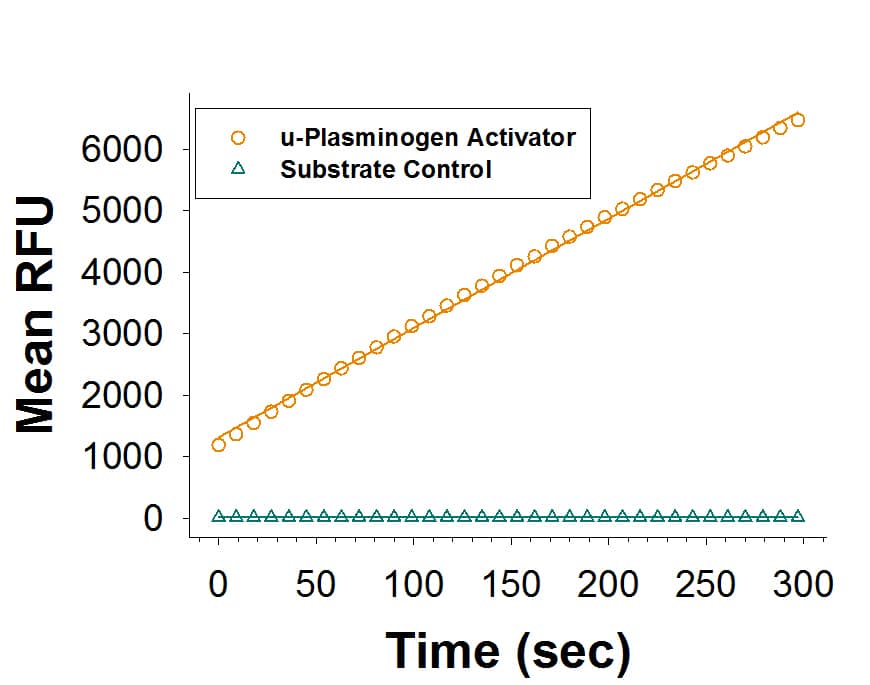Recombinant Human u-Plasminogen Activator/Urokinase, CF Best Seller
R&D Systems, part of Bio-Techne | Catalog # 1310-SE

Key Product Details
Product Specifications
Source
Met1-Leu431 with a C-terminal 10-His tag
Purity
Endotoxin Level
N-terminal Sequence Analysis
Predicted Molecular Mass
SDS-PAGE
Activity
The specific activity is >2,000 pmol/min/µg, as measured under the described conditions.
Scientific Data Images for Recombinant Human u-Plasminogen Activator/Urokinase, CF
Recombinant Human u-Plasminogen Activator/Urokinase Enzyme Activity
Recombinant Human u-Plasminogen Activator/Urokinase (Catalog # 1310-SE) is measured by its ability to cleave a peptide substrate, N-carbobenzyloxy-Gly-Gly-Arg-7-amido-4-methylcoumarin (Z-GGR-AMC).Formulation, Preparation and Storage
1310-SE
| Formulation | Supplied as a 0.2 μm filtered solution in HEPES, NaCl and CaCl2. |
| Shipping | The product is shipped with polar packs. Upon receipt, store it immediately at the temperature recommended below. |
| Stability & Storage | Use a manual defrost freezer and avoid repeated freeze-thaw cycles.
|
Background: u-Plasminogen Activator (uPA)/Urokinase
uPA is a serine protease with an extremely limited substrate specificity, cleaving the sequence Cys-Pro-Gly-Arg560-Val561-Val-Gly-Gly-Cys in plasminogen to form plasmin (1). uPA is a potent marker of invasion and metastasis in a variety of human cancers associated with breast, stomach, colon, bladder, ovary, brain and endometrium (2). For example, the combination (both low vs. either or both high) of uPA and its inhibitor, plasminogen activator inhibitor-1 (PAI-1), outperforms the single factors as well as other traditional prognostic factors with regard to risk group assessment for breast cancer, particularly in node-negative breast cancer (3). The human uPA is initially synthesized as 431 amino acid precursor with a N-terminal signal peptide (20 residues) (4‑6). The single chain molecule is processed into a disulfide-linked two-chain molecule. The B chain starting at Ile179 corresponds to the catalytic domain. Two forms of the A chain exist, one starting at Ser21 (the long form) and the other at Lys156 (the short form). The resulting two-chain forms have different molecular weights (MW). The B chain is common for both forms whereas the long and short A chains are unique to the high and low MW forms, respectively. The long A chain contains an EGF-like domain, which is responsible for binding of the uPA receptor (uPAR). Both high and low MW forms exist in the purified recombinant human uPA.
References
- Ellis, V. (2004) in Handbook of Proteolytic Enzymes. Barrett, A.J. et al. eds., Academic Press, San Diego, pp.1677.
- Duffy, M.J. (2002) Biochem. Soc. Trans. 30:207.
- Harbeck, N. et al. (2002) Clin. Breast Cancer 3:196.
- Riccio, A. et al. (1985) Nucleic Acids Res. 13:2785.
- Nagai, M. et al. (1985) Gene 36:183.
- Jacobs, P. et al. (1985) DNA 4:139.
Long Name
Alternate Names
Gene Symbol
UniProt
Additional u-Plasminogen Activator (uPA)/Urokinase Products
- All Products for u-Plasminogen Activator (uPA)/Urokinase
- u-Plasminogen Activator (uPA)/Urokinase Activity Assays
- u-Plasminogen Activator (uPA)/Urokinase cDNA Clones
- u-Plasminogen Activator (uPA)/Urokinase ELISA Kits
- u-Plasminogen Activator (uPA)/Urokinase Lysates
- u-Plasminogen Activator (uPA)/Urokinase Primary Antibodies
- u-Plasminogen Activator (uPA)/Urokinase Proteins and Enzymes
- u-Plasminogen Activator (uPA)/Urokinase Simple Plex
Product Documents for Recombinant Human u-Plasminogen Activator/Urokinase, CF
Product Specific Notices for Recombinant Human u-Plasminogen Activator/Urokinase, CF
For research use only
